Create
Vintage St. Pete: Raising the Sunshine Skyway Bridge
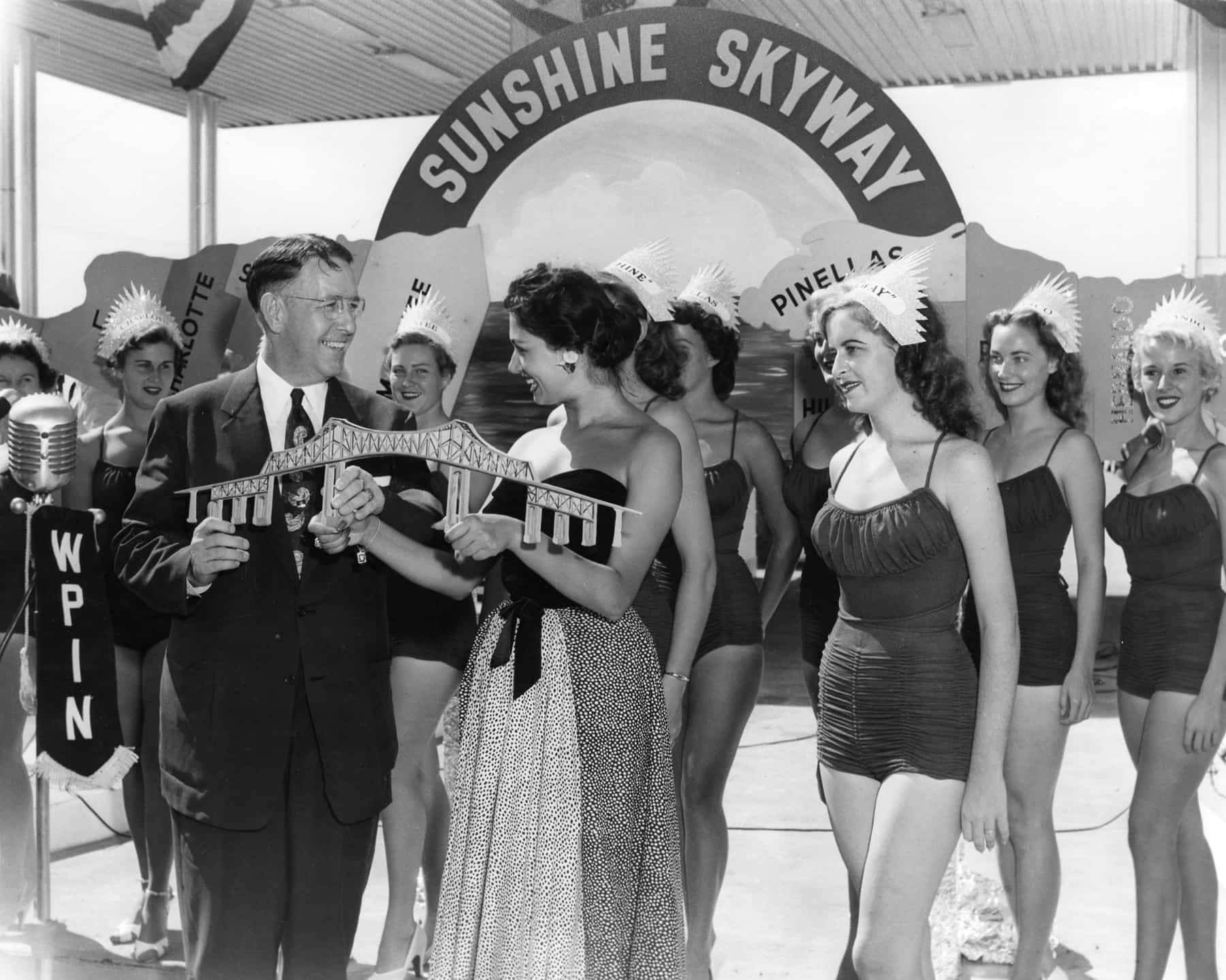

This color illustration of the Sunshine Skyway Bridge was sold as a souvenir in 1954. From the author’s collection.
Dan McCarty was dead.
The 31st governor of Florida suffered a massive heart attack in February, 1953, and seven months later he was permanently out of office.
This meant that Charley E. Johns, president of the State Senate and one of the most controversial figures in Florida politics, was Acting Governor when the Sunshine Skyway Bridge was dedicated over Labor Day Weekend, 1954.
Johns was a segregationist, a proponent of the death penalty and, later in his career an architect of the notorious Florida Legislative Investigation Committee, which “investigated” and persecuted homosexuals, radicals, academics and suspected communists.
Johns was never elected governor; he ran in the next election but was soundly defeated by the ever-more-charismatic (and doggedly anti-segregationist) State Senator LeRoy Collins.
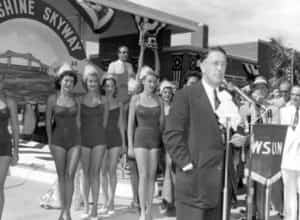
September 6, 1954: Acting governor Charley E. Johns dedicates the Sunshine Skyway Bridge.
Nevertheless, Johns’ most historic freeze-frame was captured on Sept. 6, 1954, as the then highest-ranking state official at the opening of the 15-mile, state-of-the-art bridge across lower Tampa Bay.
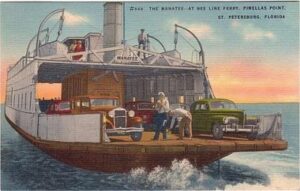 The two-lane, $22 million crossing replaced the aging Bee Line Ferry, a fleet of big-bellied boats that carried automobiles, and their passengers, from Pinellas Point on the north side to Piney Point in Manatee County. Each one-way trip took 45 minutes.
The two-lane, $22 million crossing replaced the aging Bee Line Ferry, a fleet of big-bellied boats that carried automobiles, and their passengers, from Pinellas Point on the north side to Piney Point in Manatee County. Each one-way trip took 45 minutes.
Four million cubic yards of sand were dredged from the bay to create the causeways on either side of the four-mile over-water bridge, which was the first such structure in the world to be constructed of concrete reinforced with steel rebar. The roadway reached its zenith, 149.5 feet in the air, directly over the shipping channel leading to the ports in Hillsborough and Manatee counties.
The bridge got its name from a contest sponsored by the St. Petersburg Jaycees, the Junior Chamber of Commerce, the Florida Department of Transportation (then known as the Road Board) and the St. Petersburg Times.
More than 20,000 suggestions were received, from which 20 finalists were chosen. Eleven of these contained the word “sun.”
Motel owner Virginia Seymour of Indian Rocks Beach came up with “Sunshine Skyway”; at the Sept. 3 dedication dinner dance at the St. Pete Coliseum, she was awarded an engraved plaque, a wristwatch and a framed painting of “her” bridge.
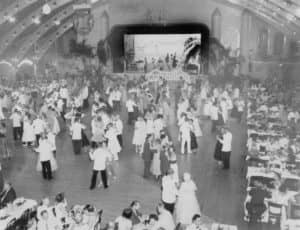
Through the addition of this fine bridge, the new Gulf Coast road will serve to make the beautiful resorts of your State most accessible to thousands of visitors traveling by automobile, and I am sure that the bridge will be a valuable addition to our national highway program.
President Dwight D. Eisenhower, letter to Charley E. Johns, July 20, 1954
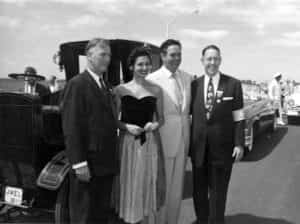
From left: Van Vleet, Diallina, Melton and Johns.
Labor Day weekend was a whirlwind of celebrations. More than 5,000 people – one of the largest crowds in St. Petersburg history – packed into Al Lang Stadium (then known as Al Lang Field) on the 4th to hear speechifying from Johns, former governor Fuller Warren, U.S. Senator Spessard Holland, Road Board chairman Cecil Webb, Collins and recently retired General James A. Van Fleet, who, like Holland, had grown up in Polk County. Pop opera singer James Melton, another Floridian, sang “The Star-Spangled Banner.”
Sept. 5 was a Sunday, with an all-faith religious ceremony at Al Lang Field. After a performance of gospel favorites from actress/singer Edith Wilson, who played Aunt Jemima in TV pancake commercials, Bishop William C. Martin, president of the National Council of Churches of Christ in America, gave the keynote speech.
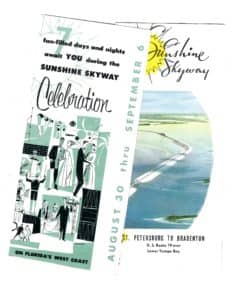 And then it was Monday, Sept. 6. Labor Day. At 10 a.m., in front of Administration Building No. 1 (the toll plaza) on the Pinellas side, Johns officially dedicated the Sunshine Skyway Bridge. The Northeast High School band played.
And then it was Monday, Sept. 6. Labor Day. At 10 a.m., in front of Administration Building No. 1 (the toll plaza) on the Pinellas side, Johns officially dedicated the Sunshine Skyway Bridge. The Northeast High School band played.
All the weekend dignitaries were there, along with – for reasons apparently lost to history – the reigning Miss Greece, Rika Diallina, who symbolically presented Johns with a small wooden cut-out of the new bridge. Behind them was a giant jigsaw puzzle depicting the 10 counties that would now be “forever linked” by the Sunshine Skyway; by inserting this final piece, Johns completed the picture.
Ten young women in red swimsuits – “bridge beauties,” the Times called them – stood at attention behind the acting governor as flashbulbs popped. Each wore a yellow crown sporting the name of one of the 10 connected counties.
The entire ceremony took less than a half hour, after which the dignitaries piled into specially-arranged cars for a motorcade south, across the Skyway. At the head of the line was singer Melton, a noted antique car collector, at the wheel of a restored 1909 Rockwell Hansom Cab. Rika Diallina rode shotgun.
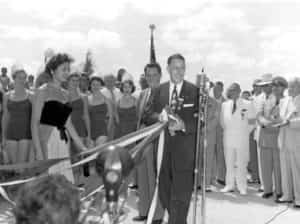
Once again, on the Manatee side.
At the Palmetto toll plaza, the entire exercise was repeated, with the bridge beauties bringing Diallina 10 symbolic ribbons, which she combined and proceeded to hand to Johns. “I present to you the united bonds of the State of Florida,” she proclaimed as flashbulbs popped again.
The speeches were more or less the same, except for Holland’s quip to the assembled southsiders: “It’s worth the $1.75 just for the view from that height.”
At 11 a.m., the Sunshine Skyway was officially opened for vehicular traffic. For Opening Day, the Road Board waived the $1.75-per-crossing fee. Drivers could make the journey, both ways, as many times as they liked, for free.
At 11 p.m., the toll went into effect. The final tally: 15,000 vehicles crossed in the first 12 hours.

May 19, 1971. Florida governor Rueben Askew dedicates the second span. Nine years later this span was struck by a freighter and collapsed.
The rest of the story
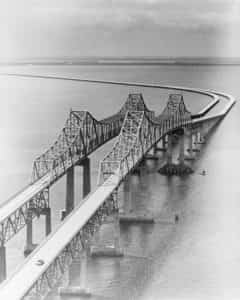 @ When the federal interstate highway system began to expand southward in the early 1960s, plans were hatched to make the Sunshine Skyway Bridge an artery. At two lanes, however, the bridge did not qualify for federal dollars, so the Road Board announced an expansion to four lanes. Governor Haydon Burns, who was instrumental in Walt Disney’s bottom-dollar purchase of Central Florida acreage for his “Southern Disneyland,” was aware that all roads – figuratively – would soon lead to Orlando. Burns fast-tracked a controversial $25 million bond issue to construct a twin Sunshine Skyway, adjacent to the 1954 model, which would allow traffic to move over two lanes in both directions. After some delays, including a costly miscalculation of exactly where the anchor pilings should be driven into the substrate, the second span opened May 19, 1971, the ribbon cut by Governor Reuben Askew. As with the first Skyway, the shipping channel, 800 feet wide between the main piers, carried massive ship traffic underneath, 365 days per year. Each span was “protected” by a wall of two-by-four wooden boards, nailed to wooden pilings.
@ When the federal interstate highway system began to expand southward in the early 1960s, plans were hatched to make the Sunshine Skyway Bridge an artery. At two lanes, however, the bridge did not qualify for federal dollars, so the Road Board announced an expansion to four lanes. Governor Haydon Burns, who was instrumental in Walt Disney’s bottom-dollar purchase of Central Florida acreage for his “Southern Disneyland,” was aware that all roads – figuratively – would soon lead to Orlando. Burns fast-tracked a controversial $25 million bond issue to construct a twin Sunshine Skyway, adjacent to the 1954 model, which would allow traffic to move over two lanes in both directions. After some delays, including a costly miscalculation of exactly where the anchor pilings should be driven into the substrate, the second span opened May 19, 1971, the ribbon cut by Governor Reuben Askew. As with the first Skyway, the shipping channel, 800 feet wide between the main piers, carried massive ship traffic underneath, 365 days per year. Each span was “protected” by a wall of two-by-four wooden boards, nailed to wooden pilings.
@ In a 1978 St. Petersburg Times story, What Could Make the Skyway Bridge Fall Down?, the Department of Transportation’s chief of bridge maintenance Jack Roberts blithely dodged the question. “How far should we go in being our brother’s keeper?” he was quoted as saying. “Should we put armor plating over houses to protect them from airplanes? Shouldn’t the ships themselves have some sort of backup systems? They go through lots of bridges.” It was later revealed that Roberts, at the time, was privately concerned about inspection reports that said both spans were showing significant wear, with cracks and worse in the concrete supports. Yet, in a direct answer to the story’s titular query, he responded: “I’d say an empty ship could do it. Some of them are very heavy.”
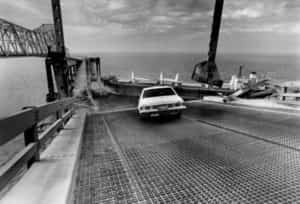 @ An empty, very heavy ship (606 feet long and weighing just under 20,000 tons) bore Roberts out on May 9, 1980. The Hong Kong-owned, Liberian-registered phosphate freighter M/V Summit Venture, in transit to the Port of Tampa, was overtaken by a sudden, violent squall just as it was to pass, eastbound, under the twin bridges. In a matter of moments, the ship’s radar was knocked out and visibility was reduced to nearly zero. The vessel’s bow clipped a main support of the southbound span – the 1971 edition – and more than 1,200 feet of roadway, including the bridge’s cantilever support and silver-steel girders 150 feet in the air – tumbled into Tampa Bay. The ship’s hastily-deployed bow anchor stopped it – just barely – from colliding with the northbound span as well. Thirty-five people, in seven cars and a passenger bus, plunged to their deaths.
@ An empty, very heavy ship (606 feet long and weighing just under 20,000 tons) bore Roberts out on May 9, 1980. The Hong Kong-owned, Liberian-registered phosphate freighter M/V Summit Venture, in transit to the Port of Tampa, was overtaken by a sudden, violent squall just as it was to pass, eastbound, under the twin bridges. In a matter of moments, the ship’s radar was knocked out and visibility was reduced to nearly zero. The vessel’s bow clipped a main support of the southbound span – the 1971 edition – and more than 1,200 feet of roadway, including the bridge’s cantilever support and silver-steel girders 150 feet in the air – tumbled into Tampa Bay. The ship’s hastily-deployed bow anchor stopped it – just barely – from colliding with the northbound span as well. Thirty-five people, in seven cars and a passenger bus, plunged to their deaths.
@ Traffic was re-routed, in both directions, to the undamaged 1954 bridge. For the next seven years, those two antiquated and flaking lanes connected the north and south sides of the bay. Then-governor Bob Graham recalled in a 2012 interview the thinking that went into a replacement. “While there was a lot of nostalgia associated with the old bridge,” Graham said, “it was an old bridge. It was, at that point, 30-plus years old – plus it was not the most elegant design. And it was a steel bridge over salt water, which is a recipe for a lot of corrosion. All of that argued not to patch the old bridge, but to build a new one. So I began talking to people about a different type of bridge, one that would stand up better.” Graham brought in the Tallahassee-based design firm Figg & Muller to design a pre-cast concrete segmental bridge, using a cable-stayed design in which the cables supporting the segmental bridge deck (elevated roadway) are laced through a “saddle system” in tall towers, called pylons. Engineer Jean Muller had pioneered this design over the River Seine in his native France.
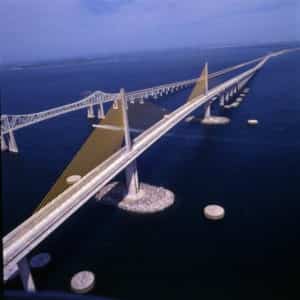 @ The $244 million bridge, 50 feet higher than the originals, and with significantly wider roadways, was dedicated in February, 1987 and opened to traffic April 30 (it took that long to finish coating the tree trunk-sized cables with bright yellow paint). More than $40 million was spent on concrete islands – known as “dolphins” – to protect the vulnerable bridge piers from a ship strike. The remains of both spans of the original Sunshine Skyway Bridge were demolished in 1993, leaving four short segments, two on each side of the bay, for use as fishing piers. Twelve years later, the “new” structure was officially re-named the Bob Graham Sunshine Skyway Bridge.
@ The $244 million bridge, 50 feet higher than the originals, and with significantly wider roadways, was dedicated in February, 1987 and opened to traffic April 30 (it took that long to finish coating the tree trunk-sized cables with bright yellow paint). More than $40 million was spent on concrete islands – known as “dolphins” – to protect the vulnerable bridge piers from a ship strike. The remains of both spans of the original Sunshine Skyway Bridge were demolished in 1993, leaving four short segments, two on each side of the bay, for use as fishing piers. Twelve years later, the “new” structure was officially re-named the Bob Graham Sunshine Skyway Bridge.
This story is included in the book Vintage St. Pete Volume II: Legends, Locations, Lifestyles (St. Petersburg Press).




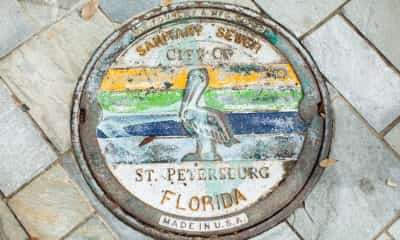



Judith Leamon Sullivan
September 5, 2022at8:09 am
Many thanks for this! My family was in one of those 15,000 cars that lined up to cross the Skyway that first day. We had always enjoyed the ferry ride but it was not an easy commute. My 1955 Manatee Leaves (high school yearbook from Bradenton) features many construction photos.